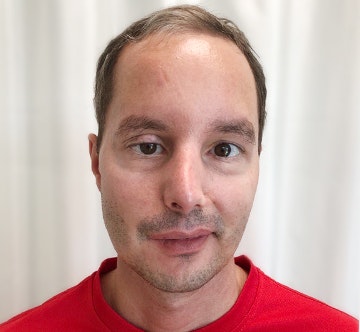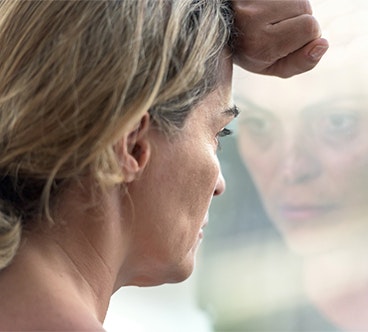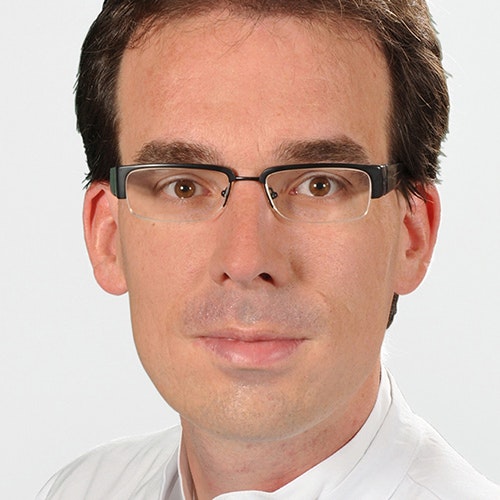STIWELL® for
facial nerve palsy
User stories

Andrew
“The surgery for my brain tumour in 2000 resulted in paralysis of almost all of my facial muscles. I could no longer close my eyelids and mouth independently and lost facial expressions. After 20 years of speech therapy, physical therapy and several rehab stays, I got introduced to the STIWELL® med4 electrical stimulation device. I have been using the device regularly since September 2020 and I can already see relevant therapy success after this short time. Once a month, the device is adjusted by my therapist according to my facial muscles and the progress I am making, otherwise I train independently at home. Due to the regular therapy with STIWELL®, it is now possible for me to close my eyelids almost completely. As a result, the inflammations in the eye area have decreased significantly and I need less eye ointment to moisten my eyes. Moreover, I have better control of my mouth muscles, which makes it easier to eat, drink and speak. However, to me the most important progress is, that I can change my facial expression again and can thus better express my emotions mimically. This has also been noticed positively by my family and friends. The significant progress has led to a clear increase in my quality of life and I am curious to see what else I can achieve with the help of electrical stimulation. ”

Ivonne
“Since 2002 I suffered from a complete peripheral facial paralysis as a result of a brain tumour surgery. A hanging corner of the mouth as well as an incomplete closure of the eyelid show the paralysis in the areas of the face and the neck. I decided to have a muscle fascia plastic surgery in 2009, but the incomplete eyelid closure as well as the asymmetry of the facial movements remained.
In July 2018, after more than 16 years, I started the therapy with electrical stimulation at home. I stimulated twice a day for 30 minutes. An increase in muscle volume soon had a clear effect on facial symmetry and a difference in movement functions (e.g. pursed lips) was no longer noticeable. I am impressed, I would not have expected this after such a long time. In contrast to other electrostimulation devices, the STIWELL® is very handy due to its size, so you are more flexible and not bound to one room. I also like the easy handling and the possibility to fix the cables with a clip on the collar/lapel and thus guarantee the best possible hold of the electrodes. ”

Albin
”After a total parotidectomy on the right, I had a post-operative peripheral facial nerve palsy with House-Brackmann Score IV (out of VI). In my case, this caused the muscle around my right eye to respond very sluggishly, and I could not close my eye completely. My facial expressions were also severely limited or absent on my right temple and around my right eye. The right corner of my mouth was sagging visibly, and not only when I was talking or laughing.
Approx. 6 weeks after surgery, I started electrical stimulation with a STIWELL® device on the advice of my doctor: 2 applications per day (30 minutes each for the area around my eye and around the corner of my mouth). Very soon (after about 1-2 weeks), the muscles and facial nerves reacted to the electrical stimuli, resulting in a significant improvement in both the muscle around my eye and the corner of my mouth. Relatively quickly, I was able to fully close my right eye again, and the corner of my mouth was no longer sagging.
After 3 months of (almost) daily use, my facial expressions, eyelid lowering, and mouth corner lift worked again in such a manner that strangers could not notice any significant impairment. I was completely satisfied with electrical stimulation with my STIWELL® device (in terms of both effort and success), and I would highly recommend it to other patients with facial nerve palsy. I am considering more therapy with STIWELL® in order to find out whether further improvement is possible, especially with regard to the existing numbness in the area where I had surgery.”

An otolaryngologist (ENT surgeon) reports...
Dr. med. Gerd Fabian Volk, otolaryngologist, reported on the use of STIWELL® for facial nerve palsy.
“I have been working in the field of facial nerve palsy, and with STIWELL®, since 2006 at the Jena University Hospital for otolaryngology, led by Prof. Dr. med. Orlando Guntinas-Lichius. Before that, I worked on the quantification and improvement of nerve regeneration during my studies in human medicine at the University of Münster in Germany.
The study on STIWELL® application, conducted jointly with MED-EL, and the resulting practical applications of electrotherapy in combination with biofeedback have shown that the motivation of patients to undergo intensive training can be increased by appropriate biofeedback.
Easy handling, combined with motivating and self-explanatory graphical information, is crucial for success. We are thus collaborating with MED-EL in order to be able to offer special motivational programmes tailored to patients with facial nerve palsy in the future.”

A speech therapist reports...
Jeannette Schulze, speech therapist, reported on the use of STIWELL® for facial nerve palsy.
“During my work at the Wilhelmshaven rehabilitation centre, we used STIWELL® to treat patients with central and peripheral facial nerve palsy of varying degrees of severity and with different duration of the disease. We applied EMG biofeedback programmes, both 1-EMG channel and 2-EMG channel, with and without electrical stimulation.
One patient with central facial palsy (after a stroke) was treated with the aim of improving his coordination. The patient (74 years of age) coped very well with the treatment. For patients with incomplete peripheral facial nerve palsy, the treatment mostly improved eye muscles and eyelid closure. These patients could move their lids faster and more often immediately after the treatment.
STIWELL® offers useful support for the treatment of central and peripheral facial nerve palsy, even in chronic cases. Fast effects were evident especially with regard to eyelid closure and eyelid movement. In general, all patients coped very well with the treatment, and were interested and motivated throughout the therapy.”
Some of the patients performed the therapy using the previous model from STIWELL®.
Our user stories are real events and therapy reports of our patients. Since it is our concern to protect them, we sometimes used Stock-photos upon request.

